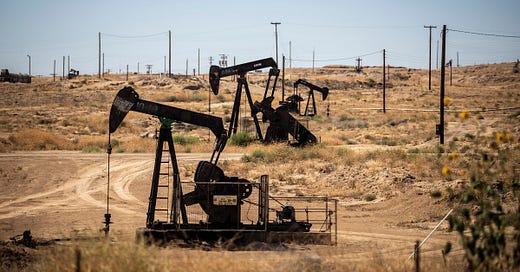California kicked off the first US oil boom in 1892, and over the next 131 years produced almost 30 billion barrels of oil. Production peaked in 1986 at 402,000 barrels a day, but has consistently fallen to under 100,000 barrels today. With the state running annual deficits of $70 billion, it may be time to bring back California’s most lucrative industry.
Edward Doheny and two friends in 1892 used picks and shovels to slant mine down to discover the world’s largest poll of oil in a town now called Beverly Hills. The fabulous “black gold” boom caused the population of sleepy Los Angeles to grow by 1,000% over the next decade.
The spectacular wealth crated by the oil business helped the United States recover from over 100 railroad bankruptcies and five years of the worst depression in US history linked to the Wall Street “Panic of 1893.”
When California’s oil production peaked in 1986 at 402,000 barrels a day, in-state oil wells satisfied 60 percent of the state’s annual consumption of 676 million barrels of oil. The industry then went into a steep decline. By 2023, California’s production of just 100,000 barrels per day satisfied less than 23% of the state’s annual consumption.
The main reason for the steep decline in California oil production was Democrat politicians slashing infrastructure investments in water resources and electric power from 18% of each year’s state budget, to 3%, and eventually to just ¾ of 1%. Given that oil drilling is energy and water intensive, it was politicians rather than economics that strangled the last California oil boom.
According to Ed Ring, California’s official commercially recoverable and proven reserves are estimated at 2.3 billion barrels. But that does not include the Monterey Shale Formation stretching across Central California that the U.S. Energy Information Administration (EIA) estimated in 2011 could hold up 23.9 billion barrels of crude oil.
That number was more than the combined reserves of America’s two largest oil fields: Texas’ Eagle Ford and North Dakota’s Bakken shale formations. At the current $78.38 a barrel for crude oil, the Monterrey Shale Formation could have generated $2 trillion.
The EIA estimate set off a fire storm for California Democrats and their allies in the Obama Administration, because drilling the Monterrey Shale Formation deposits that reside at a depth of 8,00-14,000 feet would require the use of hydraulic “fracking” to commercially bring the oil to the surface.
The entire Democrat machine that was promising their “Green New Deal” would solve the global warming climate crisis by “convert the old, gray economy into a new, sustainable economy that is environmentally sound, economically viable and socially responsible,” went into a mass rebellion against fracking.
Three years later in 2014, the Obama Administration’s EIA revised their Monterrey Shale reserve estimate down by 96% to just 600 million barrels of crude oil, or $47 billion. The EIA justified the revision based on impact of earthquakes on California’s geology and that fracked crude oil is heavier and would require slightly more refining.
Democrats under President Obama and California’s Nancy Pelosi’s were riding high in 2014. But Joe Biden is the Most Unpopular President in over 70 years with the US economy floundering in stagflation and national debt exploding higher. California is in even worse shape with Gov. Newsom issuing an emergency spending freeze with the state facing at least $200 billion in cash deficits.
With the United States and California financially imploding, the Republicans and other real change agents are going to soon have the political power to implement real economic change in Washington DC and in Sacramento. Moving to kick off a $2 trillion Monterrey Shale boom seems like an obvious opportunity for new leadership
.




